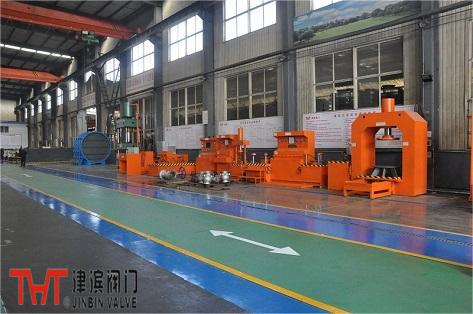3. Pressure reducing valve pressure test method
① The strength test of the pressure reducing valve is generally assembled after a single test, and it can also be assembled after the test. Duration of strength test: 1min with DN<50mm; DN65 ~ 150mm longer than 2min; If the DN is greater than 150mm, it is longer than 3 minutes. After the bellows are welded to the components, 1.5 times the maximum pressure after the pressure reducing valve is applied, and the strength test is carried out with air.
② The tightness test is carried out according to the actual working medium. When testing with air or water, the test is carried out at 1.1 times the nominal pressure; When testing with steam, it is carried out at the highest allowable working pressure at the operating temperature. The difference between the inlet pressure and the outlet pressure should not be less than 0.2MPa. The test method is as follows: after the inlet pressure is adjusted, the adjusting screw of the valve is gradually adjusted so that the outlet pressure can be sensitively and continuously changed within the maximum and minimum value range, without stagnation and blockage. For the steam pressure reducing valve, when the inlet pressure is removed, the valve is closed and then the valve is cut off, and the outlet pressure is the highest and lowest value. Within 2 minutes, the appreciation of the outlet pressure should comply with the provisions. For water and air pressure reducing valves, when the inlet pressure is adjusted and the outlet pressure is zero, the pressure reducing valve is closed for sealing test, and no leakage within 2 minutes is qualified.
4. Butterfly valve pressure test method

The strength test of the pneumatic butterfly valve is the same as that of the globe valve. The sealing performance test of the butterfly valve should introduce the test medium from the inflow end, the butterfly plate should be opened, the other end should be closed, and the injection pressure should reach the specified value; After checking that there is no leakage in the packing and other seals, close the butterfly plate, open the other end, and check that there is no leakage in the butterfly plate seal. Butterfly valves used for flow regulation do not perform sealing performance tests.
5. Plug valve pressure test method
①When the plug valve is tested for strength, the medium is introduced from one end, the rest of the path is closed, and the plug is rotated to the fully open working position for test, and the valve body is not found to be leaking.
② In the sealing test, the straight-through cock should keep the pressure in the cavity equal to the passage, rotate the plug to the closed position, check from the other end, and then rotate the plug 180° to repeat the above test; The three-way or four-way plug valve should keep the pressure in the cavity equal to one end of the passage, rotate the plug to the closed position in turn, introduce the pressure from the right Angle end, and check the other end at the same time.
Before the plug valve test, it is allowed to apply a layer of non-acidic dilute lubricating oil on the sealing surface, and no leakage and expanded water droplets are found within the specified time. The test time of the plug valve can be shorter, generally stipulated as l ~ 3min according to the nominal diameter.
The plug valve for gas should be tested for air tightness at 1.25 times the working pressure.
6.Diaphragm valve pressure test method
The diaphragm valve strength test introduces the medium from either end, opens the valve disc, and closes the other end. After the test pressure rises to the specified value, it is qualified to see that the valve body and valve cover have no leakage. Then reduce the pressure to the tightness test pressure, close the valve disc, open the other end for inspection, no leakage is qualified.
7.Stop valve and throttle valve pressure test method
The strength test of the globe valve and throttle valve is usually put the assembled valve in the pressure test rack, open the valve disc, inject the medium to the specified value, and check whether the valve body and valve cover are sweating and leaking. Strength test can also be carried out individually. The tightness test is only for the stop valve. During the test, the stem of the stop valve is in a vertical state, the valve disc is opened, the medium is introduced from the bottom end of the valve disc to the specified value, and the packing and gasket are checked. When qualified, close the valve disc and open the other end to check whether there is leakage. If the valve strength and tightness test are to be done, the strength test can be done first, and then the pressure is reduced to the specified value of the tightness test, and the packing and gasket are checked. Then close the valve disc, open the outlet end to check whether the sealing surface leakage.
Post time: Aug-11-2023
